

Fear and Fever: Dublin’s struggle with typhoid
Free self-guided walking tour
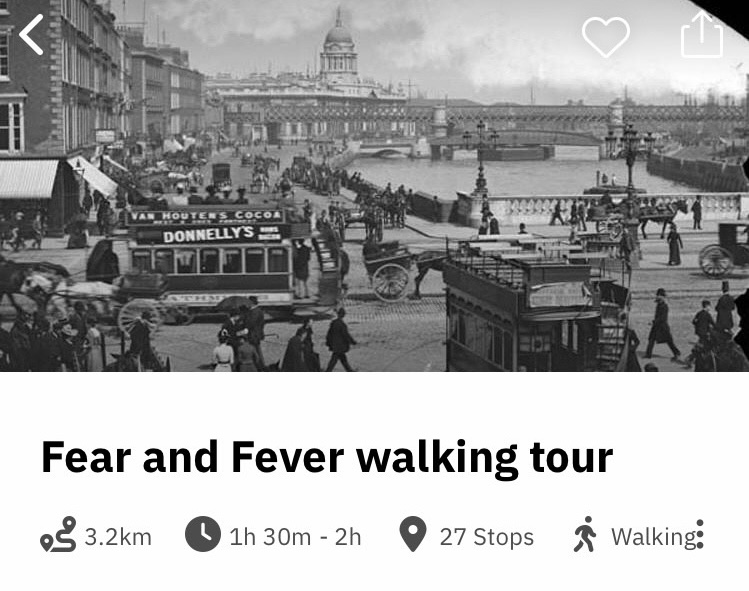
The ‘Fear and Fever’ walking tour on the Stqryguide app.
About this tour
100 years ago, Dublin had a deadly reputation: poverty, overcrowding, and bad sanitation made the city a breeding ground of infectious disease. Typhoid was one of the most notorious. Join Elizabeth (Lizzie) Byrne, Dublin Corporation’s second woman sanitary officer, on this guided walking tour of disease and public health in Edwardian Dublin.
Learn about the everyday tragedies connected to typhoid, the factors that enabled its spread, and how Dublin authorities tried to stop it. And finally, discover what the unappetising connection is between typhoid and Dublin’s famous daughter, Molly Malone.
The tour includes narration alongside key historic visual material that brings to life the “Dear Dirty Dublin” of c.1900.
![]()
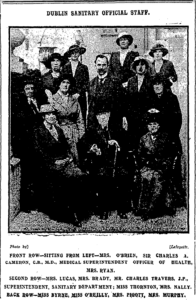
Lafayette, Dublin Sanitary Offical Staff, 1915
About Elizabeth (Lizzie) Byrne, your tour narrator.
Lizzie Byrne was a real person, who was appointed as Dublin’s second woman sanitary sub-officer in 1899. Although we know an unusual amount about Lizzie’s lower middle-class life, important details such as she when she died or retired are lost to history. Click here to find out more about Lizzie’s biography.
The fictional Lizzie you will meet during this tour and our presentation of her (how we think she may have sounded and thought) is based on key historical sources such as the census, newspaper reports, and the records of the Public Health Department. We also draw on the annual reports compiled by Dublin’s Medical Superintendent Officer of Health Sir Charles Cameron. Between 1910 and 1916, these included a series of reports written by the women sanitary officers themselves regarding their work – and particularly measures they undertook to reduce high infant mortality. You can read a transcription of one of Lizzie’s own reports here. We’ve used specific details from this particular report for one of Lizzie’s descriptions of the role of a lady sanitary officer (Stop 9: Sanitary inspecting in the Liberties).
Our decision to feature a real-life historical sanitary sub-officer as the guide for this tour is based on the Typhoidland project’s research on the role of women in Edwardian Dublin’s public health workforce.
![]()
Practical details
Location: Dublin (city centre), Ireland.
Length: 3.2kms. The tour should take somewhere between 90 and 120 minutes, depending on your walking pace.
Accessibility: You’ll encounter steps on three occasions during the tour – Stop 7 (‘Jonathan Swift and Dublin’s decline’), Stop 15 (‘The Fearless Frogman’) and between Stop 15 and Stop 16. If you want to avoid these, use the map to find an alternative route and manually play the audio tracks you would otherwise miss.
What you need: Just your charged smartphone and some headphones! No data required; just download over wifi beforehand.
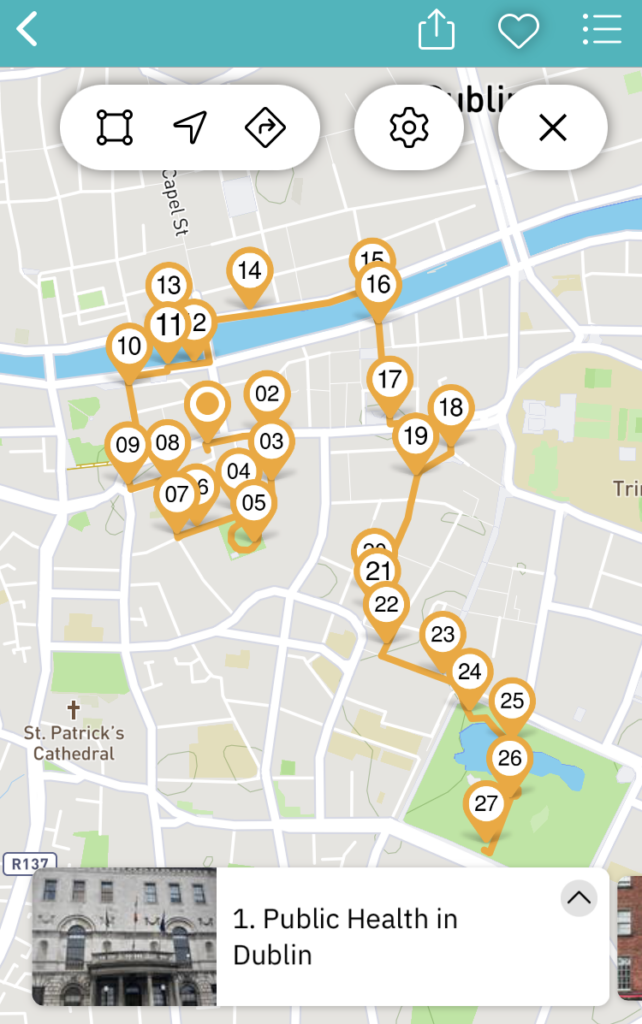
Walking Tour Route.
How the tour works
This is a self-guided walking tour which you need to download on your smartphone via the Stqryguide App (instructions below) – we recommend doing this over wifi in advance to avoid any data charges. The tour uses GPS technology to autoplay audio content. You will be given clear verbal instructions throughout, but there is also a map available on the app. You’ll find a guide to using the app on the Fear and Fever homepage on Stqryguide.
![]()
In Dublin and raring to go?
Step 1: Scan this QR code on your smartphone to download the Stqryguide app:

Step 2: Open the Stqryguide app on your phone and type ‘Fear and Fever’ into the search box. Then select the ‘Fear and Fever’ button (shown below):
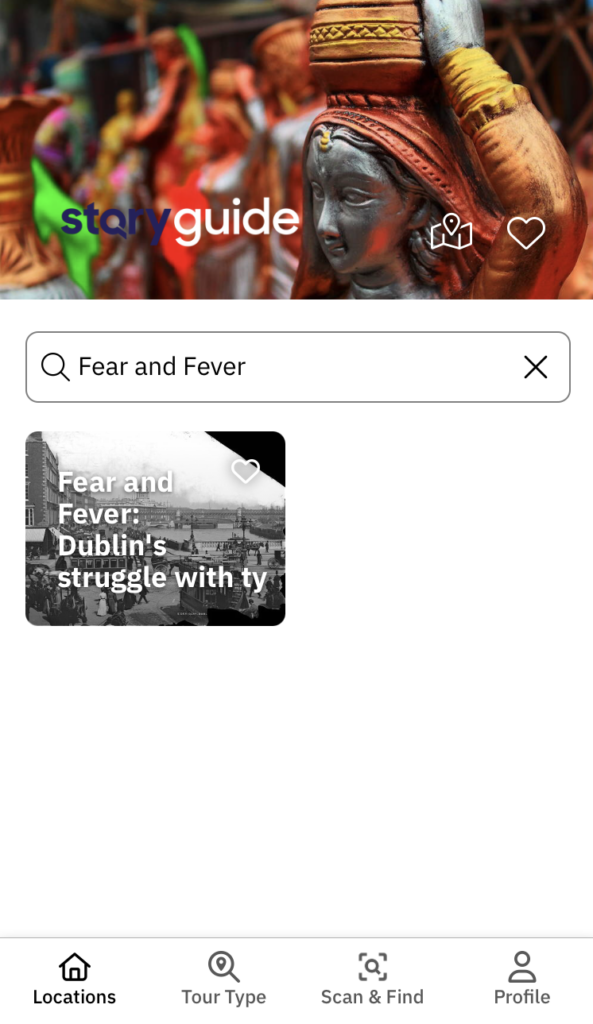 Step 3: Follow the instructions to download the tour and find out where it begins. Once you’re at the start, click the Start Tour button on the app to launch the tour.
Step 3: Follow the instructions to download the tour and find out where it begins. Once you’re at the start, click the Start Tour button on the app to launch the tour.
Not in Dublin? Doesn’t matter!
Take the virtual tour online here.

The ‘Fear and Fever’ walking tour on the Stqryguide app.
About this tour
100 years ago, Dublin had a deadly reputation: poverty, overcrowding, and bad sanitation made the city a breeding ground of infectious disease. Typhoid was one of the most notorious. Join Elizabeth (Lizzie) Byrne, Dublin Corporation’s second woman sanitary officer, on this guided walking tour of disease and public health in Edwardian Dublin.
Learn about the everyday tragedies connected to typhoid, the factors that enabled its spread, and how Dublin authorities tried to stop it. And finally, discover what the unappetising connection is between typhoid and Dublin’s famous daughter, Molly Malone.
The tour includes narration alongside key historic visual material that brings to life the “Dear Dirty Dublin” of c.1900.
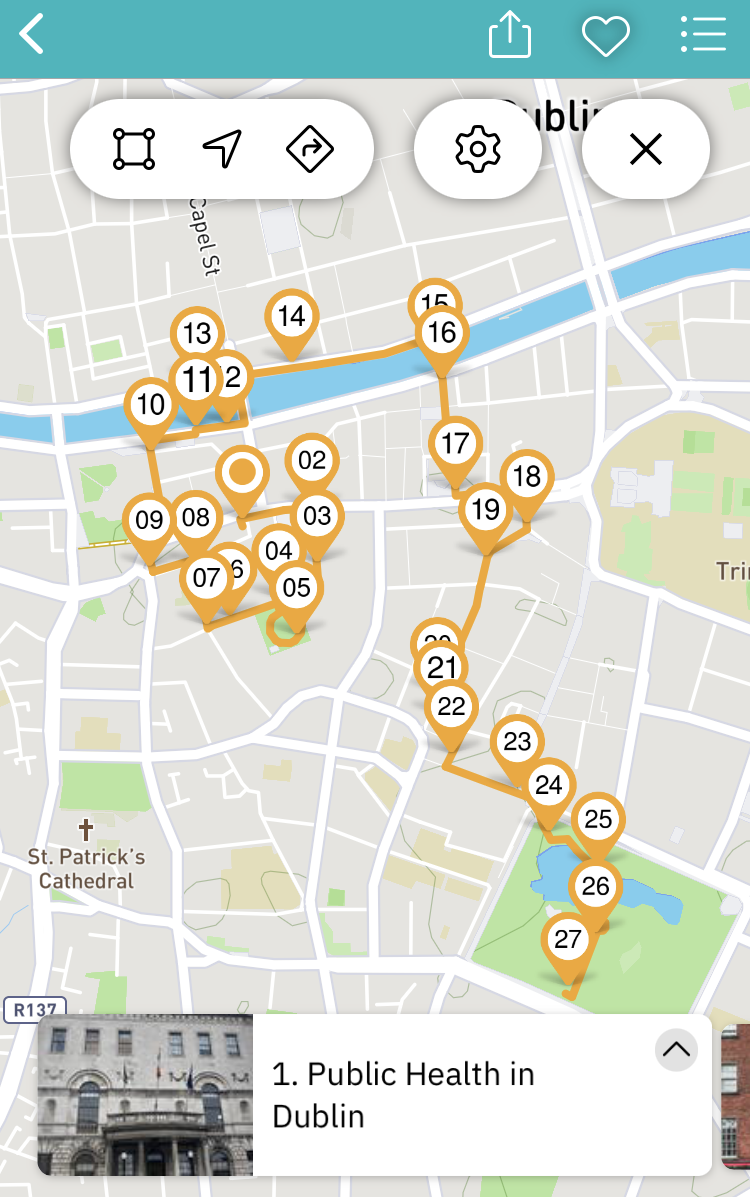
Walking tour route.
How the tour works
This is a self-guided walking tour which you need to download on your smartphone via the Stqryguide App (instructions below) – we recommend doing this over wifi in advance to avoid any data charges. The tour uses GPS technology to autoplay audio content. You will be given clear verbal instructions throughout, but there is also a map available on the app. You’ll find a guide to using the app on the Fear and Fever homepage on Stqryguide.
![]()
In Dublin and raring to go?
Step 1: Download the Stqryguide app on your smartphone:
Step 2: Open the Stqryguide app on your phone and type ‘Fear and Fever’ into the search box. Then select the ‘Fear and Fever’ button (shown below):
 Step 3: Follow the instructions to download the tour and find out where it begins. Once you’re at the start, click the Start Tour button on the app to launch the tour.
Step 3: Follow the instructions to download the tour and find out where it begins. Once you’re at the start, click the Start Tour button on the app to launch the tour.
Not in Dublin? Doesn’t matter!
Take the virtual tour online here.
![]()
Practical details
Location: Dublin (city centre), Ireland.
Length: 3.2kms. The tour should take somewhere between 90 and 120 minutes, depending on your walking pace.
Accessibility: You’ll encounter steps on three occasions during the tour – Stop 7 (‘Jonathan Swift and Dublin’s decline’), Stop 15 (‘The Fearless Frogman’) and between Stop 15 and Stop 16. If you want to avoid these, use the map to find an alternative route and manually play the audio tracks you would otherwise miss.
What you need: Just your charged smartphone and some headphones! No data required; just download over wifi beforehand.
![]()
Precautions and disclaimer.
Dublin is a busy city. Stay aware of your surroundings; take care when you’re crossing roads and use pedestrian crossings wherever possible. Watch out for uneven surfaces and any other hazards. Users of this audio tour are responsible for their own safety at all times.

Lafayette, Dublin Sanitary Official Staff, 1915.
About Elizabeth (Lizzie) Byrne, your tour narrator.
Lizzie Byrne was a real person, who was appointed as Dublin’s second woman sanitary sub-officer in 1899. Although we know an unusual amount about Lizzie’s lower middle-class life, important details such as she when she died or retired are lost to history. Click here to find out more about Lizzie’s biography.
The fictional Lizzie you will meet during this tour and our presentation of her (how we think she may have sounded and thought) is based on key historical sources such as the census, newspaper reports, and the records of the Public Health Department. We also draw on the annual reports compiled by Dublin’s Medical Superintendent Officer of Health Sir Charles Cameron. Between 1910 and 1916, these included a series of reports written by the women sanitary officers themselves regarding their work – and particularly measures they undertook to reduce high infant mortality. You can read a transcription of one of Lizzie’s own reports here. We’ve used specific details from this particular report for one of Lizzie’s descriptions of the role of a lady sanitary officer (Stop 9: Sanitary inspecting in the Liberties).
Our decision to feature a real-life historical sanitary sub-officer as the guide for this tour is based on the Typhoidland project’s research on the role of women in Edwardian Dublin’s public health workforce.
Precautions and disclaimer.
Dublin is a busy city. Stay aware of your surroundings; take care when you’re crossing roads and use pedestrian crossings wherever possible. Watch out for uneven surfaces and any other hazards. Users of this audio tour are responsible for their own safety at all times.
![]()
Credits.
Concept and script: Carly Collier.
Narration: Ruth McGill.
Recorded at Windmill Lane Recording Studios, Dublin.
Credits.
Concept and script: Carly Collier.
Narration: Ruth McGill.
Recorded at Windmill Lane Recording Studios, Dublin.


